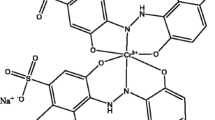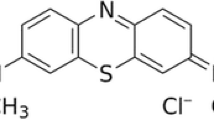Abstract
The removal of bromophenol blue dye (BPB), from aqueous solutions, by biosorption on a non-living biomass of Rhizopus stolonifer was investigated in a batch system. Pretreatment of the biomass with NaOH was found to be the most effective means to enhance the biosorption of BPB. The fungal biomass exhibited the highest dye sorption capacity at pH 2 and the uptake process followed the pseudo-second order reaction model. The equilibrium sorption capacity of the biomass increased as the initial dye concentration increased, and the maximum uptake value was estimated at 1111 mg/g according to Langmuir adsorption isotherm. The adsorbed dye was easily desorbed from a fungal biomass with 0.1 M NaOH solution and the regenerated biomass could be reused for other biosorption essays with similar performances.
Similar content being viewed by others
References
Aksu, Z. (2005). Application of biosorption for the removal of organic pollutants: a review. Process Biochemistry, 40, 997–1026.
Al-Degs, Y., Khraisheh, M. A. M., Allen, S. J., & Ahmad, M. N. (2000). Effect of carbon surface chemistry on the removal of reactive dyes from textile effluent. Water Research, 34, 927–935.
Banks, C. J., & Parkinson, M. E. (1992). The mechanism and application of fungal biosorption to colour removal from raw water. Journal of Chememical Technology and Biotechnology, 54, 192–196.
Banat, I. M., Nigam, P., & Marchant, R. (1996). Microbial decolorization of textile-dye contaning effluents: a review. Bioresource Technology,58, 217–227.
Choy, K. K. H., McKay, G., & Porter, J. F. (1999). Sorption of acid dyes from effluents using activated carbon. Resource Conser. Recycling, 27, 57–71.
El-Geundi, M. S. (1991). Color removal from textile effluents by adsorption techniques. Water Research, 25, 271–273.
Freundlich, H. (1907). Uber die adsorption in losungen. Journal of Physical chemisty, 57, 385–470.
Fu, Y., & Viraraghavan, T. (2001). Fungal decolorization of wastewaters: a review. Bioresource Technology, 79, 251–262.
Fu, Y., & Viraraghavan, T. (2002). Removal of congo red from an aqueous solution by fungus. Aspergillus niger. Advance Environment Research 7, 239–247.
Gadd, G. (1990). Biosorption. Chemistry and Industry, 2, 421–426.
Gallagher, K. A., Healy, M. G., & Allen, S. J. (1997). Biosorption of synthetic dye and metal ions from aqueous effluents using fungal biomass, In: Wise, D. L. (Eds.), Global environmental biotechnology. Amsterdam: Elsevier.
Hoog, G. S., & Guarro, J. (1995). Atlas of clinical fungi. Centraalbureau voor Schimmelcultures. Reus, Spain: Univeesitat Rovira I Virgili.
Hu, T. L. (1996). Removal of reactive dyes from aqueous solution by different bacterial genera. Water Science and Technology, 34, 89–95.
Juang, R. S., Tseng, R. L., Wu, F. C., & Lee, S. H. (1997). Adsorption behavior of reactive dyes from aqueous solutions on chitosan. Journal of Chemical Technology and Biotechnology, 70, 391–399.
Kapoor, A., & Viraraghavan, T. (1995). Fungal Bisorption—An alternative treatment option for heavy metal bearing wastewaters: A review. Bioresource Technology, 53, 195–206.
Kirby, N., McMullan, G., & Marchant, R. (1995). Decolorisation of an artificial textile effluent by Phanerochaete chrysosporium. Biotechnology Letters, 17, 761–764.
Langmuir, I. (1918). The adsorption of gases on plane surfaces of glass, mica and platinium. Journal of American Chemical Society, 40, 1361–1368.
Largergren, S. (1898). Zur theorie der sogenannten adsorption geloster stoffe. Kungliga Svenska Vetenskapsakademiens. Handlingar, 24, 1–39.
Lin, S. H., & Liu, W. Y. (1994a). Continuous treatment of textile wastewater by ozonation and coagulation. Journal of Environment Engeering ASCE, 120, 437–446.
Lin, S. H., & Peng, F. C. (1994b). Treatment of textile wastewater by electrochemical methods. Water Research, 2, 277–282.
Lin, S. H., & Peng, F. C. (1996). Continuous treatment of textile wastewater by combined coagulation, electrochemical oxidation and activated sludge. Water Research, 30, 189– 196.
McKay, G., & Ho, Y. S. (1999). Pseudo-second order model for sorption processes. Process Biochemistry, 34, 451– 465.
Morais, L. C., Freitas, O. M., Goncalves, E. P., Vasconcelos, L. T., & Gonzalez Beca, C. G. (1999). Reactive dyes removal from wastewaters by adsorption on eucalyptus bark: variables that define the process. Water Research, 33, 979–988.
Nigam, P., Banat, I. M., Singh, D., & Marchant, R. (1996). Microbial process for the decoloration of textile effluent containing azo, diazo and reactive dyes. Process Biochemistry, 31, 435–442.
O'Mahony, T., Guibal, E., & Tobin, J. M. (2002). Reactive dye biosorption by Rhizopus arrhizus biomass. Enzyme and Microbial Technology, 31, 456–463.
Ramakrishna, K. R., & Viraraghvan, T. (1997). Dye removal using low cost adsorbents. Water Science and Technology, 36, 189–196.
Riddell, R. W. (1950). Permanent stained mycological preparation obtained by slide culture. Mycologia, 42, 265–270.
Robinson, T., Mcmullan, G., Marchant, R., & Nigam, P. (2001). Remediation of dyes in textile effluent: a critical review on current treatment technologies with a proposed alternative. Bioresource Technology, 77, 247–255.
Salen, I. A. (2000). Kinetics of the oxidative color removal and degradation of bromophenol blue with hydrogen peroxide catalyzed by copper (II) supported alumina and zirconia. Applied Catalysis B, 28, 153–162.
Tsai, W. T., Chang, C. Y., Ing, C. H., & Chang, C. H. (2004). Adsorption of acid dyes from aqueous solution on activated bleaching earth. Journal of Colloid Interface Science, 275, 72–78.
Tsezos, M., & Volesky, B. (1981). Biosorption of uranium and thorium. Biotechnology and Bioengeering, 23, 583–604.
Waranusantigul, P., Pokethitiyook, P., Kruatrachue, M., & Upatham, E. S. (2003). Kinetics of basic dye (methylene blue) biosorption by giant duckweed (Spirodela polyrrhiza). Environmental Pollution, 125, 385–392.
Author information
Authors and Affiliations
Corresponding author
Rights and permissions
About this article
Cite this article
Zeroual, Y., Kim, B.S., Kim, C.S. et al. Biosorption of Bromophenol Blue from Aqueous Solutions by Rhizopus Stolonifer Biomass. Water Air Soil Pollut 177, 135–146 (2006). https://doi.org/10.1007/s11270-006-9112-3
Received:
Accepted:
Published:
Issue Date:
DOI: https://doi.org/10.1007/s11270-006-9112-3




